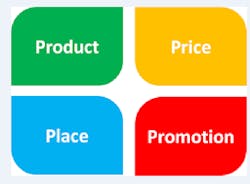Cadillacs, Cookies, Cigarettes, and Electric Service
If you were doing a study of brands of cars, and asked people if they would be willing to pay a price premium for a Cadillac, some survey participants would reply: “Of course--it’s a Cadillac!” For brands like Cadillac, which have created sufficiently high perceived value, positive benefits tend to make lower price a lower priority.
Unfortunately, when we take an overly price-centric approach to the strategic marketing planning process for our smart grid related products and service offerings, we tend to make these higher value-add “non-price” aspects of our strategic product positioning secondary to price.
If a survey asks you whether you’d be willing to pay a price premium for rooftop solar PV or a green pricing program, aren’t you being biased by the wording of the question, to view something as an extra cost that could instead have been positioned as an added value? If such a survey’s participants are part of the related target market, the way such survey questions are worded can detract from, rather than enhance, the value of the marketing offering the surveys purportedly are helping to develop. And such a survey’s marketing personnel, if too price-centric in their thinking, will be creating pathways for commodification to become a self-fulfilling prophecy. (A measure is whether they are making the offering really “sexy” or “cool,” or whether, instead, they are taking an engineering economics or “better mousetrap” approach.)
Several years ago I noticed displays of cookies above the cash registers at an airport’s store, and I ended up buying one of the cookies, because I realized it was from a company my brother’s ex-mother-in-law had formed. “Wow, her cookie is overpriced!” was my first thought, as I opened the package and bit into the cookie. “This cookie tastes like cardboard!” was my second thought, followed by “this cookie is too dry and crumbly, and doesn’t taste sweet at all.”
Although I wanted to tell myself that this cookie should be a total marketing failure, I had to fetch myself up and swallow hard (both my pride and the tasteless, dry cookie) because I knew this cookie was creating multi-million dollar annual profits.
I had momentarily forgotten the classic strategic marketing concept of the Four P's: Product, Price, Place and Promotion. Instead, I had allocated too much importance to product and price, and had underestimated the value of place (or placement) and promotion.
The second thing that happened that day, as I went back and looked in again at the store, was what I noticed about the display of cigarettes behind the cash register. There were so many varieties of one popular brand of cigarette, I had to rub my eyes--there were “lite” and regular versions, and standard length versus 100mm sizes, and flip top versus soft pack, and across most of these three dimensions there were five flavor offerings, colored red, green, blue, gold, and black, plus some color combinations I couldn’t comprehend, totaling more than 40 different, distinct varieties of that one brand.
Is this brand proliferation the last gasp (pun intended) of a dying industry, or marketing genius, or both?
Electric service may be labeled as a “commodity,” with price being the dominant dimension, and service-level driven reliability also being in play for key customers on higher reliability electric rate plans (or tariffs). But obviously, there are other factors that can permit significant value-add, e.g. when it comes to various payment options, or the marketing of demand response programs, or energy efficiency, time of use rates, home energy networks, high-end thermostats, rooftop solar PV, green pricing plans, and smart grid offerings. And the 4 P's of marketing always apply, and can enable a brand experience to be designed to be less price-centric and more value-driven, whether for relatively simple or more complex electric utility rate plans, or for a wide range of smart-grid offerings.
Note how the higher price plays an interesting role with branding the cookie, which was promoted as sugar-free, gluten free, and organic, and also had promotion of the fact that a portion of the profits from its sale were being given to certain charities. Specifically, for some buyers, the higher price of the cookie was very likely a positive factor, due to the greater weight or value they attached to these non-price aspects. In other words, for that segment of buyers, if the price of the cookie had been lower, some would have perceived the cookie to be of lower value, and would not have bought it.
Can our industry afford to better differentiate its product offerings and marketing? Can our industry afford to NOT do so?
My examples may seem unfair, since cookies and cigarettes can be addictive. But overall, our electricity habit is more strongly entrenched than nicotine or cookies.
You may argue that a substantive and more “unfair” difference stems from the lower profitability of electric utilities, which leads to lower marketing budgets compared to cookies and cigarettes.
But I disagree, because I see a “chicken vs. the egg” issue here, when it comes to marketing budgets and profitability comparisons across these areas.
Specifically, I do not know whether cigarette and cookie manufacturers are able to fund the higher levels of product differentiation they’ve achieved, because their products are more profitable than electric service, or whether their products are more profitable than electric service, because they’ve been able to fund higher levels of product differentiation.
I suspect both factors are in play. Therefore, to whatever extent utilities have the mandate or wherewithal, they should try to spend more to develop, test market, and differentiate new brands and offerings more strategically.
The cookie and cigarette examples show that market segmentation and product differentiation of a brand across multiple dimensions can reduce big, seemingly overwhelming obstacles. Such differentiation within a brand can create value where the product was viewed negatively, or viewed, at best, as a commodity alongside competing, equally commodified, brands. And creating a large number of dimensions for differentiation enables that brand’s customer base to feel a stronger connection to the brand, and creates loyalty, and interest, and a willingness to pay more for more perceived (and actual) value.
Speaking of not smoking, could someone tell me what is stopping utilities from adding new rate plans to appeal to segments in their customer base who are less interested in green power offerings, and more interested in helping fund R&D for clean coal and carbon capture? Is this being done and I’ve not seen it published anywhere yet?
Save
About the Author
Peter Arvan Manos
Utility Industry Analyst
Peter Manos is Director of Research for Electric Power & Smart Grid, on the Energy Sector team at ARC. He analyzes the latest trends across People, Process, and Technology to uncover business and digital transformation best practices for electric, gas, and water utilities. He can be reached at [email protected]

